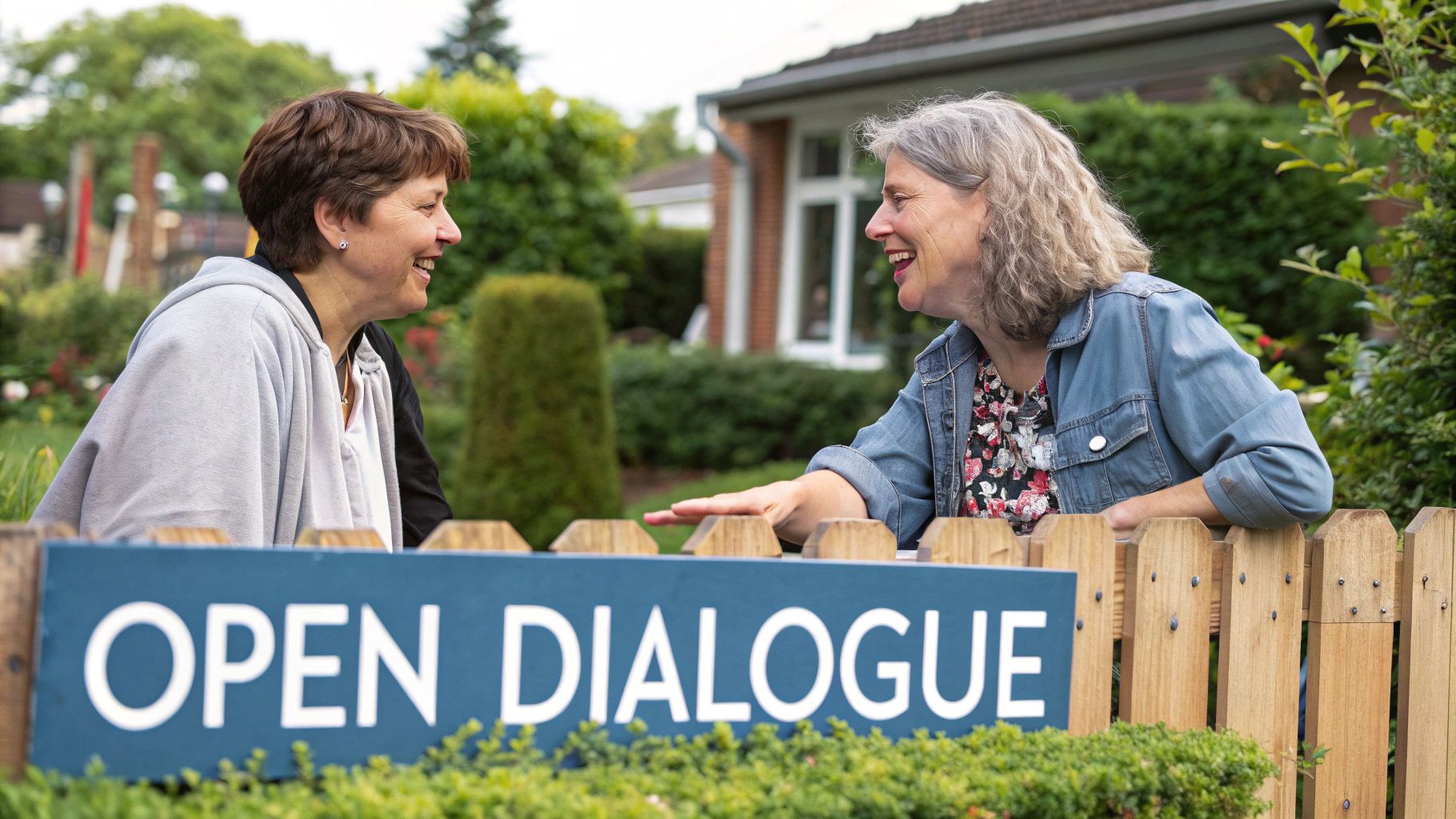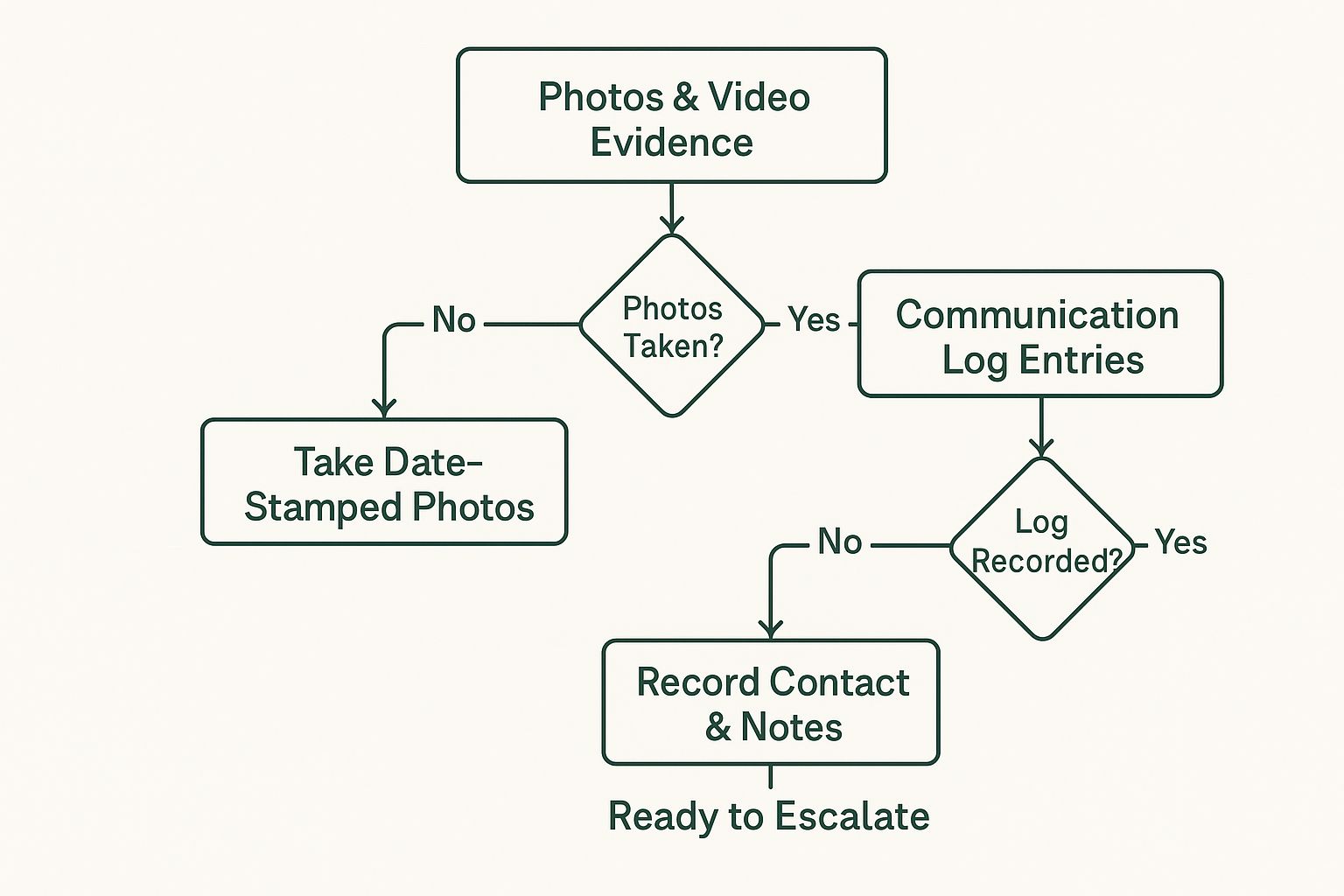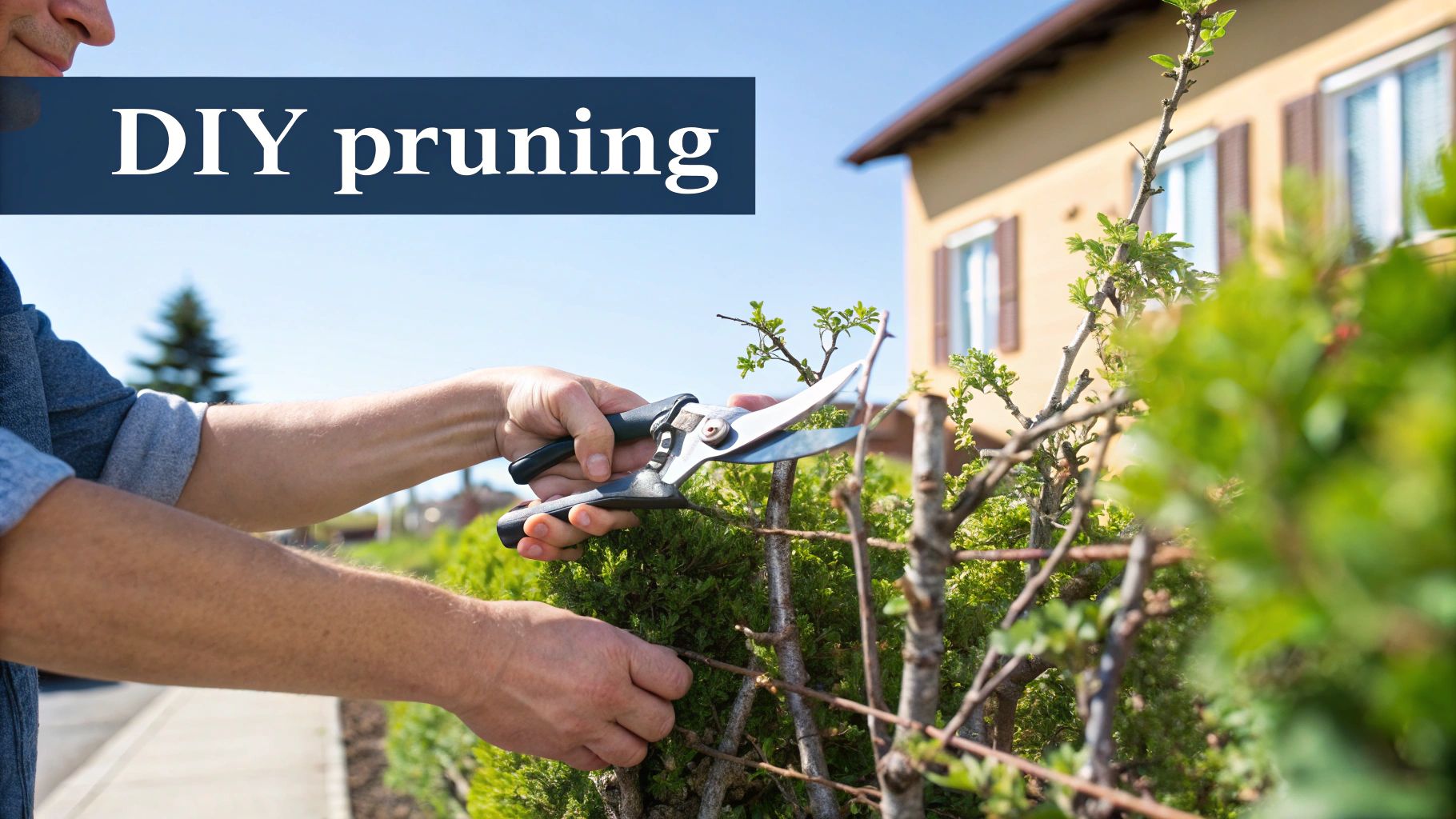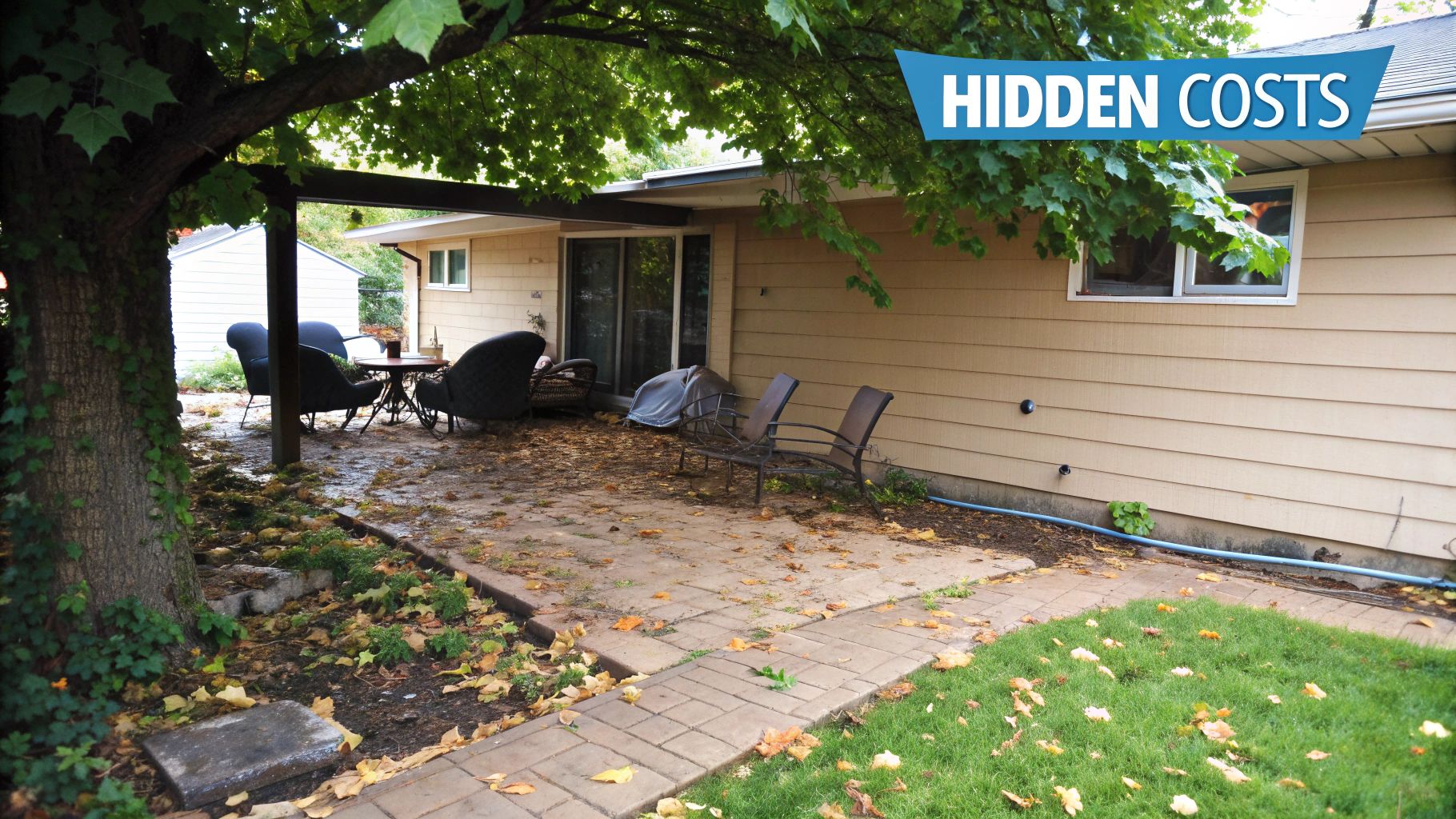Neighbours Trees Overhanging My Property: Know Your Rights and Options
- Swift Trees Perth
- Oct 15
- 14 min read
When your neighbour’s trees start creeping over the fence, it’s a classic suburban dilemma. The good news is you have a legal standing known as the common law right of 'abatement'. This basically means you can prune any branches that cross onto your property. But hold on before you fire up the chainsaw—it’s not quite a free-for-all. You have to do the trimming from your side of the fence, and only cut back to the boundary line.
Understanding Your Rights with a Neighbour's Overhanging Trees
Discovering a neighbour's tree encroaching on your space can be frustrating. What was once a pleasant green backdrop can quickly become a source of stress, dropping leaves in your pool or blocking out the sun. Before you reach for the loppers, it's really important to get your head around your legal rights and responsibilities. Getting this right from the start empowers you to act confidently and legally, and can stop a minor annoyance from blowing up into a full-blown neighbourhood war.
The key principle here is that 'right of abatement' we mentioned. It allows you to remove the nuisance yourself—in this case, the branches hanging over your yard. This right, however, comes with some very firm boundaries.
Key Rights and Responsibilities
You can only trim what hangs over your side of the property line. It’s tempting to want to give the tree a "proper" haircut for the sake of aesthetics, but cutting anything beyond your boundary could land you in hot water for trespassing or damaging your neighbour's property.
And here’s a quirky bit of law: any branches you cut technically still belong to your neighbour. This means you have a legal obligation to offer them back. Just be warned, chucking them over the fence can be seen as illegal dumping, so a quick chat is always the better option.
A classic scenario we see all the time is when a neighbour's big gum tree constantly clogs up gutters with leaves, creating a real risk of water damage. Under the right of abatement, you’re well within your rights to prune the specific branches causing the problem, as long as they’re over your side of the boundary.
Sometimes, the issue is more than just annoying debris. In Australia, the problem of a neighbour's overhanging trees is a surprisingly frequent cause of disputes. Some states have even passed specific laws to deal with it. For example, the Trees (Disputes Between Neighbours) Act 2006 in New South Wales allows property owners to go to court for orders to prune trees that are severely blocking sunlight or views. It's worth a Google to see if your state has similar legislation.
When to Pause and Check Regulations
Before you make a single cut, it’s crucial to make sure the tree isn’t protected. Some trees have a Tree Preservation Order (TPO) on them or might be located in a conservation area. This means you’ll need council permission before you or an arborist can do any work.
To find out more about the rules that might apply, you can check out our guide on permits for regulated trees. Acting without checking could lead to some seriously hefty fines.
Ultimately, knowing your rights is your first and most powerful tool. It clarifies what you can do straight away and what requires a more careful approach, ensuring you solve the problem without creating a new, more complicated one.
Starting a Constructive Conversation

Before you reach for the loppers or start drafting formal letters, the best first step is almost always a simple chat over the fence. This initial conversation is your golden opportunity to sort out the problem of a neighbour's trees overhanging your property without souring the relationship.
Honestly, a lot of the time, your neighbour might not even realise their tree has become an issue for you. Life gets busy, and what's happening on the other side of the fence isn't always top of mind.
Approaching them calmly is the key. If you go in with accusations, they'll likely get defensive. But if you frame it as a shared problem, you’re much more likely to find a solution together. A friendly tone can make all the difference.
How to Frame the Conversation
Your goal is to be clear about the issue without pointing fingers. The best way to do this is to focus on the impact the overhanging branches are having on your side. Whether it’s blocking out all your winter sun, dropping branches near the kids' swing set, or just making a constant mess, explaining the specific effect makes your request feel reasonable, not demanding.
Here are a few ways to get the chat started on the right foot:
Lead with something positive. A simple, "Your garden's looking fantastic this season," or, "The new paint job on the house looks great," can set a friendly, relaxed tone from the get-go.
Use "I" statements. Kicking off with "Your tree is..." immediately sounds accusatory. Instead, try phrases like, "I'm getting a bit worried about..." or "I've noticed..." This keeps the focus on your experience.
Suggest working together. An opener like, "I was hoping we could have a quick chat about a solution for the big gum tree," frames it as a mutual challenge, not a one-sided complaint.
A practical example: Instead of marching over and saying, "Your messy tree is wrecking my pool filter," you could try something like this: "G'day, Bill. I'm having some trouble with leaves from the big jacaranda clogging up my pool filter, and I was wondering if we could figure out a way to manage the overhanging branches together? I'm happy to get a quote from an arborist we could maybe split."
This approach is all about inviting cooperation. It shows you respect them and their property and you're just trying to find a win-win outcome. Being a good neighbour really does go a long way.
When a Face-to-Face Chat Isn't Possible
Of course, sometimes a face-to-face chat just isn't on the cards. Schedules clash, or maybe you just don't feel comfortable bringing it up in person. In those situations, a polite, well-worded note can be just as effective.
Just keep it brief, friendly, and to the point. Here’s a simple template you can adapt:
Subject: A quick question about your tree
Body: "Hi [Neighbour's Name], Hope you're well. I wanted to gently raise the issue of the branches overhanging from your lovely [tree type] into my yard. They've started to [mention the specific problem, e.g., block the gutters/drop a lot of debris on the patio]. Would you be open to having a chat about getting them trimmed back? Let me know when is a good time. Cheers, [Your Name] at number [Your House Number]."
Putting it in writing gives your neighbour a moment to think about it without feeling put on the spot, and it creates a clear, friendly record of your request.
Ultimately, open and respectful communication is the most powerful tool you have. But if the job requires more than a simple trim, especially with large or high branches, getting professional help is always the safest and most effective way forward.
Documenting the Issue for Clarity
So, your friendly chat over the fence didn't quite do the trick. Before you think about escalating things, your next best move is actually to start documenting. This isn’t about gearing up for a legal showdown; it’s about creating a clear, objective record of what’s happening and the reasonable steps you've already taken to sort it out. A solid log can be incredibly helpful if you end up needing to go down a more formal path like mediation later on.
Think of it as putting together a simple, factual timeline. This approach takes the emotion out of the situation and focuses everyone on the core facts of the neighbours trees overhanging my property. When you do this right, you're actually strengthening your position by showing you’ve acted responsibly from the get-go.
Capturing Visual Evidence
The most powerful tool you have right now is your phone's camera. A picture really is worth a thousand words, especially when it shows exactly how a tree is impacting your property.
Start taking clear, date-stamped photos and videos. Don't just snap one picture and call it a day. Get shots from a few different angles and at various times of the day to show the full picture. For example, a photo in the morning might show branches hanging dangerously low over your roofline, while a shot from the afternoon could highlight how much shade they cast over your solar panels, killing your energy savings.
Get specific with what you're capturing:
The Overhang: Get clear shots showing exactly where the branches cross over your boundary line.
The Impact: Take photos of any problems this is causing, like gutters completely clogged with leaves, a patio covered in debris, or paving stones stained by fallen fruit.
Potential Damage: If branches are physically rubbing against your roof or walls, get some close-up photos of any scuffs or wear marks.
This kind of visual evidence makes the problem real and hard to ignore. It shifts the conversation from a vague "your tree is a bit messy" to "here’s a photo from last Tuesday showing your branches blocking my gutter."
Maintaining a Communication Log
Alongside your photos, you'll want to keep a straightforward, factual log of every conversation you have with your neighbour. This doesn't need to be anything fancy—a simple notebook or a document on your computer works perfectly.
For every time you talk, just jot down:
The date and time of the chat.
A quick, unbiased summary of what you discussed (e.g., "Mentioned the overhanging branches and offered to split the cost of an arborist").
Any actions or solutions you both agreed on.
This log demonstrates a pattern of reasonable and consistent effort on your part. Should the dispute ever require third-party intervention, this objective record proves you’ve done everything possible to resolve the matter amicably first.
This infographic breaks down the key steps for creating a solid record of the issue.

As you can see, combining visual proof with a written log gives you a complete and factual account, putting you in a great position for whatever comes next.
While documenting is a crucial step, remember that if the pruning itself involves working at height or near hazards, it’s a job for the professionals.
Deciding Between DIY Pruning and Hiring a Pro

When you're dealing with a neighbour's tree creeping over your fence, the urge to just grab a pair of loppers and sort it out yourself can be overwhelming. A quick trim seems like a simple, cost-effective fix.
But what starts as a small weekend job can quickly spiral into a dangerous and expensive mistake. It’s crucial to know your limits.
Legally, you are permitted to prune branches up to your property's boundary line. For small, low-hanging branches from a shrub or little tree that you can easily reach from the ground with secateurs, a DIY approach can be perfectly fine. We're talking about minor annoyances, not major hazards.
The moment you start eyeing a ladder or thinking about firing up a chainsaw, it’s time to stop and take a breath. The risks of working at height or handling powerful equipment without proper training are huge. A falling branch can cause serious injury or do a real number on your property, your neighbour’s property, or even public utilities.
Red Flags That Signal You Need an Arborist
Some situations are just non-negotiable and demand the skills of a qualified arborist. Trying to tackle these yourself isn't just risky; it could leave you liable for any damage that follows. Think of these as clear stop signs for any DIY ambitions.
Here are the tell-tale signs that it’s time to call in a professional:
Working at Height: If any part of the job requires you to leave the ground, whether on a ladder or by climbing, it's an arborist's job. They have the safety gear and training to work high up without incident.
Large Branches: Any branch thicker than your wrist is a serious risk. A professional knows how to make precise cuts to control where that heavy timber falls, protecting your fences, roof, or anything else below.
Near Power Lines: This is an absolute no-go zone for DIY. Touching a power line with a tool—or even a falling branch—can be fatal. Professionals are trained to work safely around these electrical hazards.
Signs of Disease or Decay: If the tree looks sick—with dead branches, fungus, or cavities in the trunk—its structural integrity could be shot. An arborist can assess the tree's health and figure out the safest way to prune it without making things worse.
A practical example: A client called us after trying to trim a large branch from their neighbour's gum tree that was hanging over their new carport. He lost control, and the branch crashed through the roof, causing thousands in damage. The cost of a professional arborist would have been a tiny fraction of the repair bill.
Trying to save a bit of cash can lead to disastrous outcomes. To get a better sense of the potential pitfalls, it's worth learning about common **DIY tree care mistakes** and why leaving it to the professionals is almost always the smartest choice.
To make the decision clearer, here’s a quick-reference guide to help you decide whether to handle the pruning yourself or bring in the experts.
DIY Pruning vs Professional Arborist: When to Choose Which
Ultimately, while handling minor trimming yourself can be satisfying, nothing is more important than the safety of yourself, your family, and your property. For any job that involves height, big branches, or potential hazards, the right decision is always to bring in a certified arborist.
When Communication Fails: Mediation and Legal Paths
Right, so the friendly chat over the fence didn't work. You’ve sent a polite letter, you’ve documented everything, and still, your neighbour’s branches are creeping further into your airspace. It’s frustrating, and it can feel like you’ve hit a brick wall.
Before you even think about lawyers and courtrooms, there are formal, structured ways to sort this out. These avenues are designed to get a result without the drama and expense of a full-blown legal battle.
A Smarter Way Forward: Mediation
The best next step is almost always mediation. Think of it as a guided conversation. A neutral, trained third party sits down with you and your neighbour to help you find common ground. Their job isn’t to pick a winner or loser but to help you both find a solution you can live with.
Mediation is far less confrontational than court and costs a fraction of the price. Crucially, it gives you a chance to salvage whatever is left of your neighbourly relationship.
What to Expect From Mediation Services
You can find mediation services all over Australia, usually through community justice or dispute resolution centres. The whole process is confidential, giving you both a safe space to air your grievances without things escalating.
A good mediator can help you think outside the box and come up with practical solutions you might not have considered.
Sharing the costs: They can help you draft a simple agreement to split the bill for a professional arborist.
Planning for the future: You could create a basic, written plan for how the tree will be maintained going forward.
Finding a compromise: Maybe the solution isn’t just about pruning. Perhaps your neighbour agrees to clear your gutters of fallen leaves twice a year in exchange for a bit of leeway.
The real power of mediation is that it keeps you in control. Instead of a judge telling you what to do, you and your neighbour build the solution together. An agreement you both create is one you’re both far more likely to stick to.
When All Else Fails: Legal Action as a Last Resort
If mediation doesn’t work, or your neighbour simply refuses to show up, then you might have to consider legal action. This usually means making a claim based on private nuisance or negligence.
A nuisance claim is about arguing that the overhanging branches are unreasonably interfering with your right to enjoy your property. A negligence claim is more for situations where the tree was obviously a hazard—think dead, rotting branches—and the owner did nothing, leading to actual damage.
For example, Legal Aid NT explains that homeowners in the Territory can file a small claim in a local court if a tree owner won't cooperate. To have a chance of winning, you need to prove that the neighbours trees overhanging my property have caused real damage or a serious disruption. You can get more details on how to handle these claims from Legal Aid NT.
Let's be clear: heading to court is a massive step. It's complicated, it's expensive, and it can take a serious toll. You need to weigh up the potential costs against what you’re hoping to achieve. Before taking any of these formal steps, make sure your own property is safe.
The Hidden Costs & Modern Benefits of Managing Overhanging Trees

When you're dealing with a neighbour's trees overhanging your property, the daily sweep-up of leaves and twigs is annoying enough. But the real cost often creeps up on you, hidden in the shadows until real damage is done.
Those seemingly harmless branches do more than just block your view—they starve your property of sunlight, creating a damp, shady microclimate right beside your home. This kind of environment is a perfect breeding ground for mould, mildew, and algae. You'll start noticing those ugly green or black stains on your exterior walls, pavers, and outdoor furniture.
The Impact on Your Garden and Home
The lack of sun and poor air circulation from a dense, overhanging canopy can be devastating for your garden. Patches of lawn that were once lush turn yellow and die off. Garden beds that used to burst with colour become barren and damp. While it's a common misconception that trees directly cause mould, they absolutely create the ideal conditions for it to thrive by blocking sun and airflow. You can read more on the link between trees and mould from Mould Cleaning Australia.
Enhancing Your Property's Curb Appeal and Value
Taking action isn't just about getting rid of a nuisance; it's a smart investment in your property's aesthetic and value. In today's design-conscious world, outdoor living spaces are extensions of the home. Overgrown trees can make these areas feel dark, dated, and uninviting.
A fashionable insight: Think of professional tree pruning as 'architectural gardening'. A skilled arborist doesn't just hack away branches; they sculpt the tree to enhance light, frame views, and create a sense of space. Trimming back a heavy canopy can instantly modernise a property's look, making alfresco areas brighter and more usable, which is a huge selling point for potential buyers.
In situations where a tree has become hazardous or is causing significant damage, it's vital to understand the costs involved. For a deeper look, you might find our guide on how much tree removal in Perth costs helpful.
By sorting out those overhanging branches, you're not just solving an annoyance—you're boosting your home's appearance, preventing expensive moisture-related damage, and reclaiming your outdoor living areas.
Your Path to a Peaceful Yard Starts Here
Dealing with a neighbour's overhanging branches requires a blend of legal knowledge, good communication, and knowing when to call for backup. By following these steps, you can protect your property and maintain a positive relationship with those next door.
However, when it comes to the safety of your home and family, some tasks are best left to the experts. Tackling large, high, or potentially unstable branches is not a DIY job. A qualified arborist brings the right equipment, insurance, and expertise to resolve the issue safely and efficiently, ensuring the health of the tree and the integrity of your property.
If you're facing issues with overhanging trees in the Perth area, don't let a small problem become a major dispute. The professional team at Swift Trees Perth is ready to provide expert advice and high-quality tree maintenance services.
Take the first step towards a cleaner, safer, and brighter outdoor space.
Contact us today for a free quote and let us handle your tree maintenance needs with skill and care.
